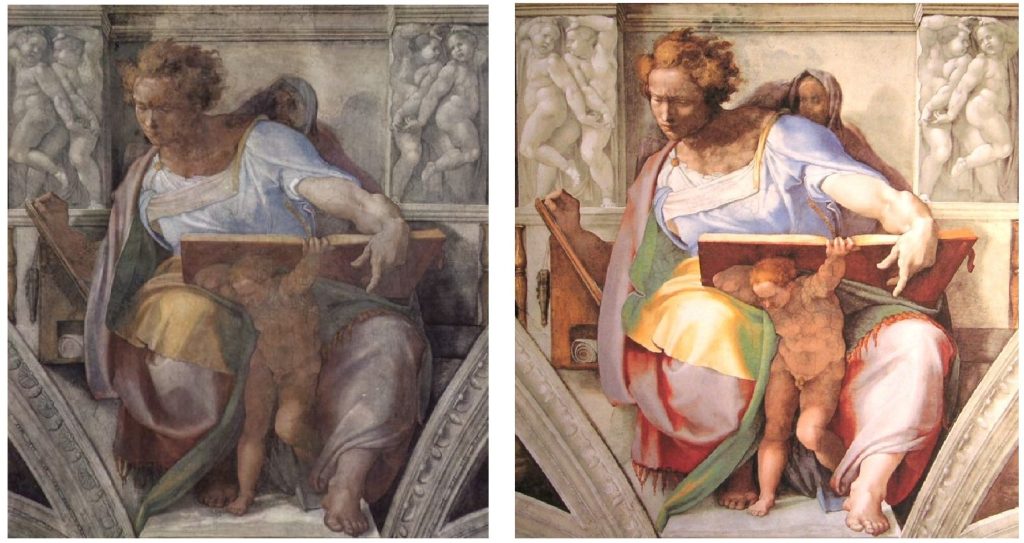Chapter 13.5: Issues of Restoration and Conservation
Artlex provides the following definition of art restoration – The work of repairing damage to artworks, bringing them back to their original condition. Unlike art conservation, this can admit the addition of elements that were not actually pieces of the original, but which are known to look just like them. Restoration techniques are used in recreating a portion of a painting that is damaged or missing, for instance. Focus on the differences between restoration and conservation.
Video
Art Conservation Behind the Scenes from the Isabella Stewart Gardner Museum offers a glimpse of the different processes and challenges of restoration and conservation.
Art Conversation Behind the Scenes (3:45)
Sistine Chapel Restoration
The Sistine Ceiling had been damaged by centuries of accumulated smoke (400 years of being lit by oil lamps and candles), cracked and falling materials, and several previous restorations of dubious quality, when it was painstakingly conserved and restored in the 1990s. The photos below show the figure of the Prophet Daniel before and after this restoration work was done.
Restoring a work of art means that changes in the visual appearance of the work will occur. Frequently, change brings controversy and divergent points of view. Two of the most hotly contested restorations in the past 15 years have centered around works of art by two of the most famous artists in Western culture: Michelangelo and Leonardo da Vinci. Pinin Brambilla Barcilon is the restorer in charge of the famous restoration of The Last Supper by da Vinci. Big Think’s article on the critics of the Sistine restoration gives us a view into the controversies surrounding the twelve-year restoration of the Sistine Ceiling by Michelangelo.
Example: Sistine Chapel, Prophet Daniel before and after restoration:

If you have the time, check out this in-depth, 49-minute video on The Sistine Restored.
Some Other Controversial Restorations
- Masaccio’s Branching Chapel, Italy
- Olmec, Michael. “The new look of the Branching Chapel discloses miracles.” (four-year cleaning of the frescoes). Smithsonian v20.n11 : pp94(9). This is available online through Puma’s library.
- The Parthenon, Greece
- Pablo Picasso’s Les Demoiselles d’Avignon from MOMA, New York.
Articles on techniques used in restoring and conserving:
- Olson, Kristin. Rocket Science and Restoration, NASAs trick for saving great paintings. DISCOVER. Vol. 22
- Conservation Center for Art and Historic Artifacts
Resources for Ethical Issues in Art Restoration:
- World Monuments Fund at Angkor Wat: Churning of the Ocean of Milk Gallery At the magnificent temple of Angkor Wat, World Monuments Fund is restoring the Churning of the Sea of Milk Gallery. Rainwater and harmful salts have leaked through the roof of the gallery, which forms the south half of Angkor Wat’s prominent east facade, damaging the fragile surface of the frieze. Without treatment, the deterioration will increase at an alarming rate, risking the eventual loss of what most historians regard as the most ambitious and finely produced stone sculptures in Khmer art.
Vandalism and Destruction of Art
Video
The Scourge of Looting: Trafficking Antiquities, from Temple to Museum (2:07)
Media Attributions
- Figure 1. Michelangelo (born Michelangelo Buonarroti) (Italian, 1475-1564), Ceiling of the Sistine Chapel, 1508-12, fresco, Vatican, Rome. Image of restoration of Prophet Daniel from the ceiling of the Sistine Chapel by Michelangelo. Image to the left is before restoration and image to the right is after restoration (Image source: PDOld, via Wikimedia Commons) is licensed under a Public Domain license
Candela Citations
- Rocket Science and Art Restoration. Authored by: Kristin Ohlson. Provided by: Discover. Retrieved from: https://www.discovermagazine.com/technology/rocket-science-and-art-restoration. License: All Rights Reserved
- Provided by: Conservation Center for Art and Historic Artifacts. Retrieved from: https://ccaha.org/. License: All Rights Reserved
- Resources for Conservation Professionals. Provided by: Conservation Online. Retrieved from: https://cool.culturalheritage.org/. License: All Rights Reserved

